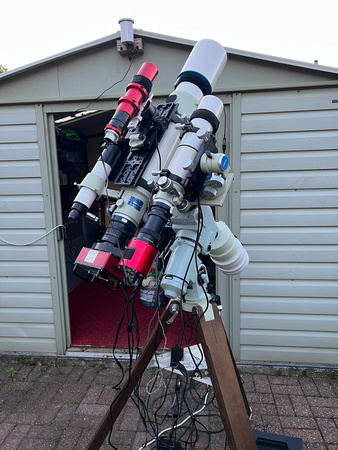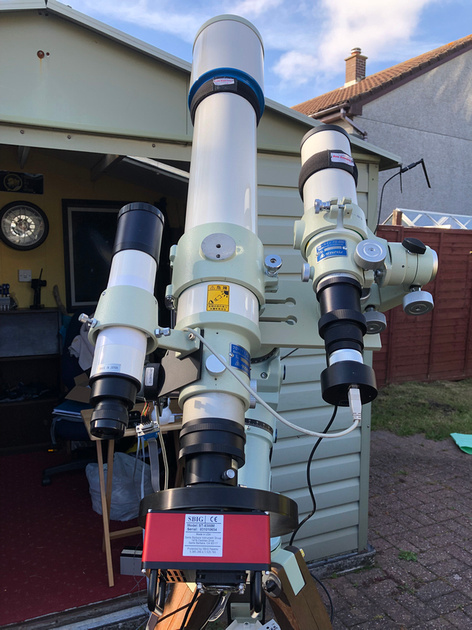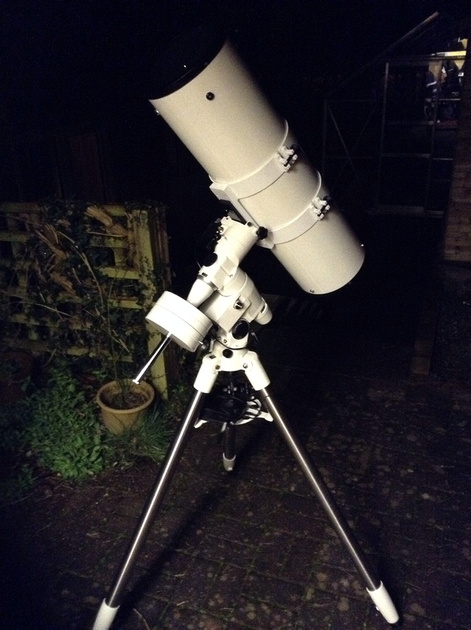2025: Current Imaging Configuration
Orion Optics UK 8" Newtonian (1/8 wave research grade optics), Baader Diamond Steeltrack focuser and the Baader MPCC coma corrector
ZWO ASI 071MC Pro, Hutch IDAS LPS D2
William Optics 50mm guidescope, QHY5L-II-M, Takahashi TGM-1 Guiding mount
Takahashi EM-200 FG- Temma 2Z
Kendrick Digifire 7 Dew heater


With this setup I wanted to explore if a fast 8" newtonian with a OSC camera would be suitable for imaging spring galaxies. It would provide a slightly longer focal length than the FS-102 refractor and with the larger aperture make up for the limitations of the OSC over the SBIG LRGB. The first task was upgrading the focuser from the stock crayford to a Baader Diamond Steeltrack to better cope with the ASI 071MC Pro and enable more precise focusing. This focuser certainly does not disappoint and is worth every penny. With the Bahtinov mask it allows quick and easy focussing prior to each session and holds the camera firmly. The MPCC coma corrector addresses the field curvature of the newtonian and although I could probably spend more time tweaking the back spacing, I was keen to get on with some imaging. I had removed the primary mirror to clean it and it took a couple of attempts refitting the cell so as not to pinch the optics. This enabled better collimation, which it seems to hold well. Balancing the rig is proving a bit of a challenge and it isn't as stable as the refractor in high winds but that's to be expected of a larger aperture telescope.
2023: Imaging Configuration
Takahashi FS-102, F/6 with reducer, SBIG ST-8300, Starlight Xpress filter wheel, Lakeside Autofocus
Takahashi FS-60Q, F/10, ZWO ASI 071MC Pro, Hutch IDAS LPS D2
William Optics 50mm guidescope, QHY5L-II-M, Skywatcher guidescope mount
Takahashi EM-200 FG- Temma 2Z
Kendrick Digifire 7 Dew heater


This year I have been playing with a side by side deep sky imaging configuration. My plan was to capture luminance data with the FS-102 and colour data with the FS60Q however in the Q setup the system is just too slow for deep sky work. I have since set up the FS-60 with the 0.72x focal reducer to try some imaging at f/4.2 again with the Optolong Dual-Band L-eXtreme filter.
2018-2023 Deep Sky Imaging Configuration
Takahashi FS-102 Fluorite Apochromatic Refractor
I use a 2001 f/8 Takahashi FS-102 as my main imaging telescope. Using the f/6 focal reducer results in a focal length of 610mm and wide image circle of 51mm. For many years I used the standard Takahashi clamshell to mount the telescope, however recently I upgraded to a dovetail plate with tube rings from TS-Optics. Given the length of the FS-102 tube, I think the clamshell configuration always suffered from some flexure and I was always doubtful about trying to over-tighten the single retaining screw on the clamshell in case it snapped. The 114mm tube rings and long 356mm dovetail plate now appear to provide a much more stable configuration, less prone to flexure. I continue to utilise a classic Takahashi side-by-side configuration for the imaging telescope and guidescope. The FS-102 is fixed to the Takahashi mounting plate using a TS Optics XL Premium Losmandy Level Saddle Plate. The guidescope is a 2004 Takahashi FS-60C. It is mounted via its clamshell to a Takahashi TGM-1 guiding mount. This allows fine adjustment of the guidescope pointing. I have often thought about changing the configuration again and mount the guidescope on top of the imaging scope with tube rings, but the TGM-1 configuration is quite elegant and seems to work well.




I use a Lakeside Autofocuser to manage precise focusing using CCDSoft @Focus via an ASCOM driver. This simple focusing programme produces very good results most of the time.
Dew control is managed using a Kendrick Digifire-7 controller and heater strips for both the FS-102 and FS-60C
The FS-102 also has a 7x50 Takahashi finderscope with integrated illuminated reticle
Takahashi EM-200 FG Temma 2Z
The mount is a Takahashi EM-200 FG Temma 2Z, the most recent version of the Takahashi Temma GOTO family. It sits on a Takahashi tripod with mahogany legs which makes for a very stable platform. I upgraded to this Temma version of the mount from my old USD-3 version. The mount is well made, in typical Takahashi fashion. The polar-alignment scope is excellent and should be usable until 2040 using the integrated reticle. The mount control panel inputs for the hand-controller and PC cable are however a little delicate, and the power cable utilises the typical red and black crocodile clips. I power the mount using a 70Ah Halfords leisure battery.
I use the Sky X Serious Edition and Temma ASCOM driver to utilise the EM-200 GOTO functionality. This is a major advantage over the original USD-3 mount and the need to use manual setting circles to locate target deep sky objects. Once I open the Sky X and connect the telescope, I slew to a bright star near the object I want to image, sync on that star, then slew to the target object which is usually in the field of view. I then take a few exposures to frame the object ready for imaging.
The mount tracks and guides well, although it does have a small degree of declination backlash, approx. 1.5 seconds at guidespeed. The PHD2 declination backlash facility does mitigate this however and in time of good seeing, the RMS total value can go down to 0.5 arc seconds. Given the urban environment from which I image, the RMS on most nights is under 1 arc sec.
Cameras
The imaging camera is an 8.3 megapixel SBIG ST-8300. It has set point cooling to maximum 40 degrees below ambient temperature. It is attached to a Starlight Xpress 2" filter wheel. The filterwheel nosepiece slots straight into the 2" eyepiece adapter attached to the focal reducer. I use Astronomik 2" CCD filters - LRGB, and 12nm hydrogen alpha, oxygen-III and sulfur-II. The filterwheel only contains five filter slots so I either have LRGB+Ha, or the narrowband filters with the luminance filter in place.
The guidescope is a QHY-5 camera, operated via the ASCOM driver and PHD2 software.
Image Acquisition and Processing
I use CCDSoft for image acquisition and focusing and up until recently image calibration/reduction/aligning and combining. I used to use NASA FITS Liberator to convert the FITS files to 16 bit TIFF files. Since April 2020 I have started to use CCDStack for image calibration and stacking. The software is very good for its data rejection algorithms and removing hot pixel columns and satellite trails. I then use Photoshop CC for image processing. My Photoshop plugins include Noise Ninja, Noel Carboni's Astronomy Tools, and Russell Croman's Gradient Xxterminator, and Starshrink.
Other equipment
Orion 8" f/4 Newtonian
I use this telescope for visual use. It has 1/8 PV wave research grade optics and when collimated well, performs superbly. I use it with my Skywatcher EQ5 mount with duel axis drives.


Takahashi EM-200 USD-3
I acquired this mount second hand in 2009. It was a great performer, but unfortunately it developed some significant declination backlash and the polar scope became misaligned. In 2017 it was sent away to a UK company for service and refurbishment but unfortunately was returned after 18 months in an unusable state. This prompted the upgrade to the Temma version of the mount.
The image below shows my imaging rig from 2010. The guidecope is mounted rigidly on top of the FS-102 clamshell and the focuser is a JMI manual focuser operated with a handbox.


Books
I use the following reference books:
- The New CCD Astronomy, Ron Wodaski
- The NewAstro Zone System for Astroimaging, Ron Wodaski, Russell Croman
- Lessons from the Masters, Robert Gendler